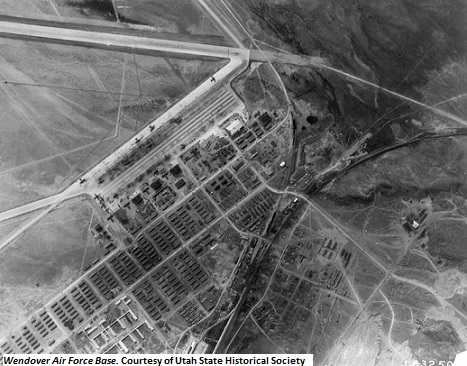Dublin Core
Title
Description
In 1945, the world's first nuclear bomb was dropped on Hiroshima, Japan, by the crew of the bomber Enola Gay. Most of us have been taught about the destruction that occurred from the atomic blast, but did you know that the tiny Utah town of Wendover played an important part in the drama that led up to the bombing?
Only a few months after the bombing of Pearl Harbor, the military turned the isolated, flat desert that surrounded Wendover Army Air Base into a prime location for training aircraft crews to drop bombs, going so far as to build a mock city at the foot of nearby mountains to make target practice more realistic. One crew that made Wendover their home was the elite 509th Composite Group, brought in to prepare for the secret mission that turned out to be the dropping of the atomic bomb over Japan. In addition to running regular drills, the 509th experimented with a variety of bomb shapes and sizes to aid engineers in the atomic bomb's construction.
Eventually the 509th left the Utah desert and flew to Tinian Island in the Pacific Ocean. President Harry Truman had given the Japanese government an ultimatum to surrender or face a weapon more terrible than anything the world had ever seen. When Japan refused, Truman gave the okay to drop the bomb. On August 6th, 1945, the Enola Gay left Tinian and dropped a weapon with the explosive force of 20,000 tons of TNT on Hiroshima. Four days later, after another bomb was dropped on Nagasaki, finally forcing the Japanese military to surrender. The Utah base where the crew of the Enola Gay trained remained open for another 31 years, until it was turned over to the city of Wendover and became a civilian airport.
Creator
Source
Image: Wendover Air Force Base. Aerial photograph of the Wendover Air Force Base in Tooele County, UT. c. 1940s. Courtesy of Utah State Historical Society.
_______________
See Charles Hibbard’s entry on Wendover Army Airfield and Onida N. Blanthorn’s entry on the community of Wendover in the online Utah History Encyclopedia at www.media.utah.edu/UHE. Also see Thomas G. Alexander, Utah: The Right Place 2d ed. (Salt Lake City: Gibbs Smith, 2003), 346-347.

